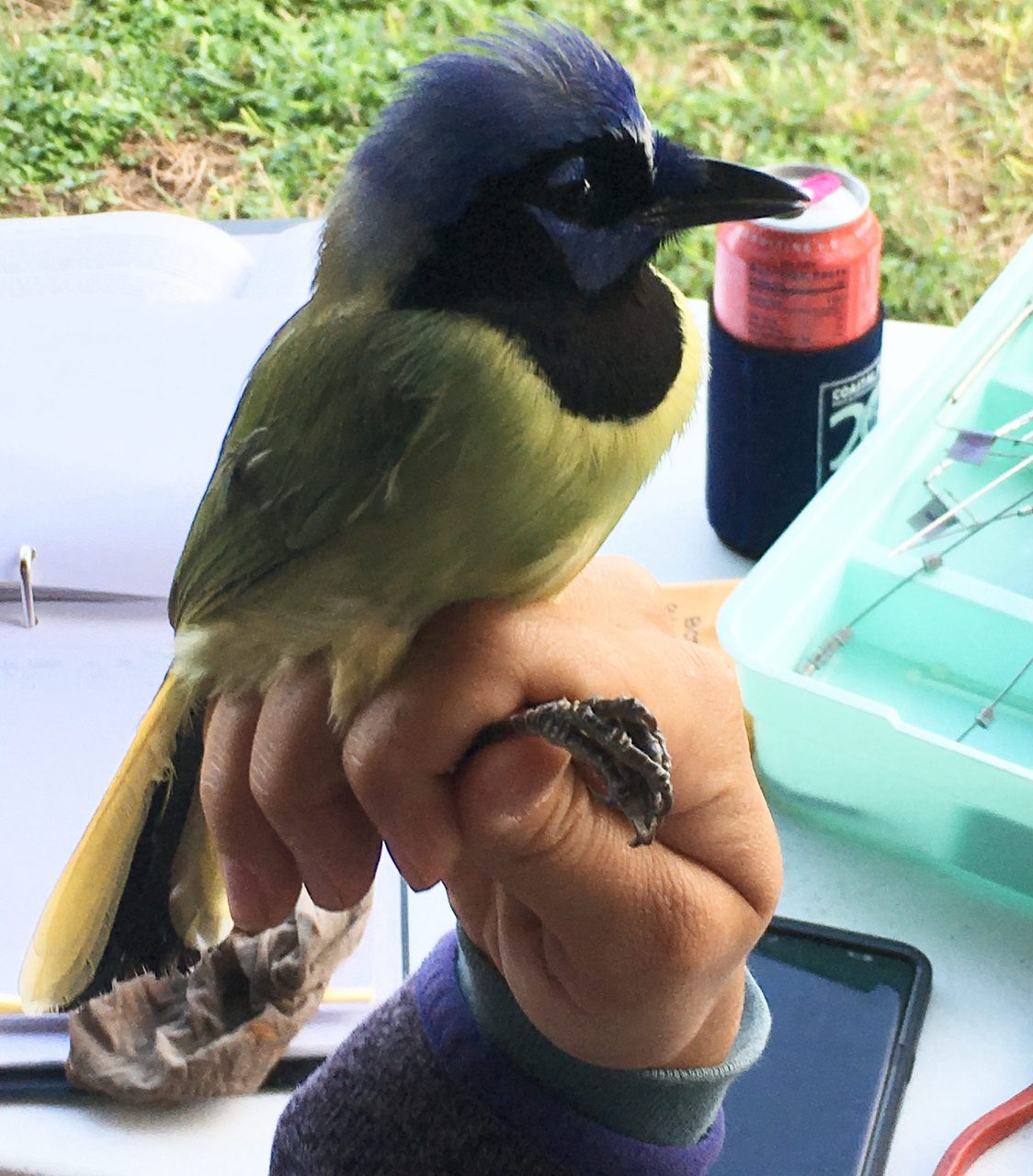by M. Kathy Raines

Bright blue caps its head, suggesting woodland shadows. Black velvet encircles its eyes, draping cheeks and throat. Olive back feathers and a lemon underbelly wash into milky green as it flutters off, dissolving into foliage, yellow blossoms and Spanish moss.
Green jays, South Texas’ pride and joy, possess startling beauty. And, being corvids—in the same family as ravens, crows, magpies and other jays—they are among the cleverest of birds.
Only five species of these highly intelligent corvids visit the Rio Grande Valley: the Tamaulipas crow, Chihuahuan raven, brown and blue jays–all of which one rarely sees—and the green jay (Cyanocorax yncas), which frequents feeders year-round at all Valley refuges, except those on South Padre Island. The Island lacks the “large tracks of continuous mature [wooded] habitat” that green jays require, according to Javier Gonzalez, Naturalist Educator at South Padre Island Birding, Nature Center and Alligator Sanctuary.
Green jays also visit suburban yards where vegetation is sufficiently thick, even those not abutting water. I have seen a large increase of green jays in my backyard in Brownsville this year, as have other residents. Perhaps a jay views a street-lined, house-dotted grove of trees as a forest with clearings. We welcome this beautiful, brainy corvid.
Like other corvids, green jays imitate voices and use tools. In fact, they are “quite smart at clearing the feeder by imitating a hawk’s call,” said Pablo Quintanilla, a staff member at Sabal Palms Sanctuary. One can observe these jays and other birds on the refuge’s webcam from 9:00-5:00 any day but Wednesday, when the center is closed: http://sabalpalmsanctuary.org/feedercam/).
Green jays have used sticks to peel back pieces of bark, searching for food. Inquisitive and alert to changes, they alarm fellow birds about lurking predators as they flap through the trees with their comrades, screaming, scolding, mobbing and driving off a hawk, snake or owl. Like other jays, a green jay may cache extra food, finding it later—perhaps deliberately or, as some researchers suspect, through coincidence.
The green jay’s genus name, “Cyanocorax” combines two Greek words, one for “dark blue” and another for “raven”. Its species name “yncas” is a Peruvian word for “Inca”.
Green jays venture north towards Corpus Christi, but in the U.S., are only common in deep South Texas. They range south to Honduras. A subspecies with a tufted crown and a brighter belly, sometimes dubbed the Inca jay, lives in South America, mainly east of the Andes.
These birds welcome tall brush, thorn scrub and trees typical of the Valley, including willow, mesquite, acacia, ebony, hackberry and oaks. In the tropics, they are drawn to damp forests, foothills and low slopes.
Being omnivorous, green jays dine on insects, fruit, small vertebrates, seeds, nuts and food they can scavenge. A jay may hold an acorn, ebony seed or nut in its feet or wedge it between things, hammering it with its long, sharp bill. It gleans leaves, branches or twigs for prey, pounces and engages in “hawking”—seizing prey midair. A troop of jays may wait in a stand of live oaks for picnickers to depart, then snatch up lunchmeat, chunks of bread and potato chips.
In late winter or springtime—depending on the weather— green jay flocks disperse, and pairs find thickets for breeding. Couples preen one another, calling softly, and the female bobs up and down, fluffs out her feathers and begs for food. The pair constructs a cup-shaped nest of thorny, interlocking twigs, lined with roots, grasses, dried moss and vine tendrils. It is well up in the canopy, from 10 to 29 feet high.
Bronzed cowbirds may pursue green jays as they prepare their nests. Brood parasites, cowbirds lay eggs in other birds’ nests, compelling these unsuspecting parents to raise cowbird chicks. Green jays frequently fall for this ruse, a phenomenon apparent to researchers; while baby jays make soft “waah” cries, cowbird chicks beg loudly for food.
The female lays 3 or 4 freckled gray, greenish or cream-colored eggs which hatch in from 17 to 18 days. Both parents feed nestlings. Chicks fledge at about 19 days, becoming independent after about two weeks. The young stay with their parents, forming part of their troop, for about a year, patrolling and defending the next year’s eggs and nestlings from predators. After that, the male patrols with the offspring, then drives them away. In Columbia, green jay yearlings—unlike those here— assist with feeding nestlings.
Green jays behave rather tamely at feeders in parks and refuges, where they investigate people, eat a few seeds, look up, eat more, then disappear, chase one another through the greenery, then return. Elsewhere, green jays are more elusive.
Their flight, which appears somewhat labored, consists of glides and quick wingbeats. Not a long-distance flier, this jay usually doesn’t stray more than 20 or 30 feet from leafy cover. A loud, boisterous bird, one of its varied calls is an “eh-eh-eh-eh”, which intensifies to a “cheh-cheh-cheh” or rattling sound when confronting a predator.
Green jays appear to be thriving, despite cowbird parasitism, and are expanding northwards. According to the North American Breeding Bird Survey, they grew 6.9% in Texas from 1966-2015. While Lake Corpus Christi State Recreational Area designated the green jay “accidental” in 1976, by 1988, they called it an “uncommon, permanent resident” in 1988. Falcon State Recreational Area altered the jay’s designation of “uncommon” in 1967 to “resident” in 1977. The oldest green jay recorded was eleven years, seven months old.
One can view green jays at feeders and in woodlands at Valley wildlife refuges as well as in forested areas of parks, commercial lots and backyards. We invite these stunning, fascinating birds by planting and preserving native trees like Mexican olive, ebony, huisache and Rio Grande ash. I feel honored to have this bright, stunning creature in my midst.

